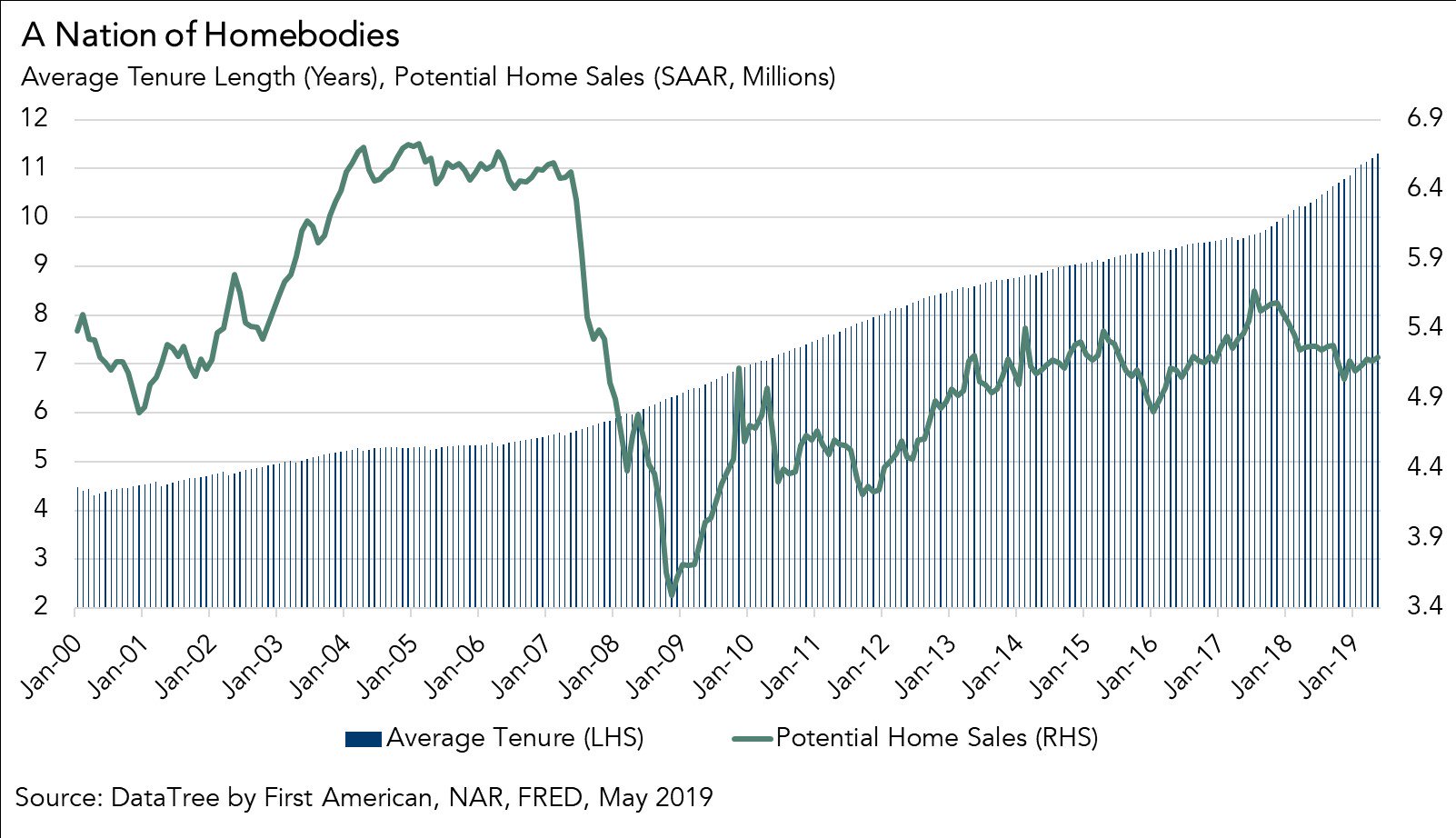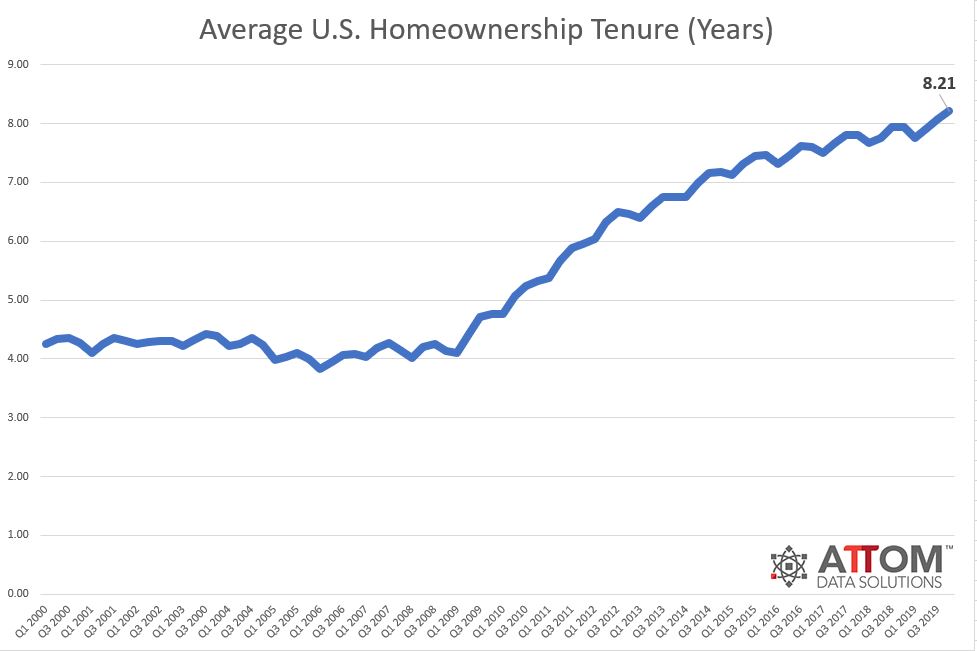The real estate industry has a lot at stake when it comes to how long people stay in their homes. The average tenure of homeownership directly drives transaction volume. An average tenure of 5 years would result in 20% annual turnover of the housing stock while a 10 year tenure would produce 10% turnover. The shorter, the better for lenders, real estate agents, appraisers, movers, and attorneys – just to name a few of the players in the buying and selling of homes. Even home buyers and sellers have a lot at stake. Home buyers want plenty of inventory to choose from – i.e. higher turnover results in more choices – while home sellers don’t want a lot of choices competing with them when selling their homes – until they put on their buyer hats.
Somehow I’ve had 7 years stuck in my head as the average tenure but NAR data says it is more like 10 years (from the 2019 Profile Of Home Buyers And Sellers), with people staying in detached homes for 10 years but condo dwellers staying for 7-8 years. Actually, that NAR data really understates the average tenure because it’s based only on people who move. Like…if half the population moves every year and the other half moves every 25 years then the NAR would report an average tenure of around 2 years when in fact it’s more like 13 years. See if you agree with my math on that.
Aside from nailing down a better number it would also be helpful to know what the trend is. I dug up a couple of sources of this information and, as you might expect, there is some discrepancy between data sources. First I looked at this data from First American Exchange Company. The graph below is terrible because the legend is confusing. I finally figured out that it’s the bar graph that plots average tenure and the scale is on the left (LHS). What it shows is a fairly steady increase from about 4.5 years at the turn of the century to 11.3 years in May 2019. That means that only about 8.8% of the housing stock is currently turning over each year.
One of the factors that First American tries to blame for this trend is low mortage rates. They theorize that people have such great mortgages that they can’t afford to give them up by moving. The only problem with that theory is that mortgage rates have been steadily dropping for the last 20 years – while the housing tenure has been rising – so people would have often benefited from moving.
In the past First American has also argued that several other factors are contributing to people staying put longer but they don’t seem well thought out:
- Lack of supply has discouraged potential home sellers because they’re afraid they won’t be able to find a suitable replacement. The only problem with this theory is that if supply is really that tight they should be able to get a record sales price for their existing home.
- Credit standards are tighter so people are afraid they won’t get approved for a new mortgage. Except credit standards have actually been loosening over the past few years – more on that another day.
- There are fewer foreclosures so people don’t have to move as much. Whaaaaaat? If you go through a foreclosure you’re not buying anything for a while and we had a huge surge in foreclosures after 2006 and the average tenure continued to increase.
First American also believes that a lot of people are prevented from moving because they are still underwater on their mortgages and wouldn’t have the money for a down payment on a new house. However, CoreLogic says that less than 4% of mortgages are underwater so I doubt this is a factor.
One other trend that First American gloms onto is seniors aging in place. OK. That one makes sense but it can’t possibly explain the magnitude of what is going on. I think the bottom line is that nobody really knows why people aren’t moving as much as they used to.
I also found the graph below from ATTOM Data Solutions in their Year-End 2019 U.S. Home Sales Report which shows the historic homeownership tenure. While the shape of the curve is roughly similar to the shape of the one from First American it is not exactly the same and it only rises to 8.21 years, which is significantly lower than First American. While First American does not explain who they are sampling ATTOM Data is clear that they are looking at people who sold their homes so it has that downward bias that I discussed above. Nevertheless, the conclusion is the same: people are definitely staying in their home much longer than they used to.
Personally, aside from the impact on the real estate industry, I can see the economic benefit of people staying put longer. Moving is costly – especially with the exorbitant commissions that home sellers and buyers choose to pay – so this trend results in less friction in the economy. On the other hand I’m a big believer in a mobile population that moves to where the opportunities are. Right now we have around 7.5 MM unfilled jobs, people working in jobs that don’t pay enough to cover their living expenses, and people struggling in high cost cities. It seems to me that greater mobility might solve some of these issues.
#RealEstate #HomeOwnership #Moving
Gary Lucido is the President of Lucid Realty, the Chicago area’s full service real estate brokerage that offers home buyer rebates and discount commissions. If you want to keep up to date on the Chicago real estate market or get an insider’s view of the seamy underbelly of the real estate industry you can Subscribe to Getting Real by Email using the form below. Please be sure to verify your email address when you receive the verification notice.

